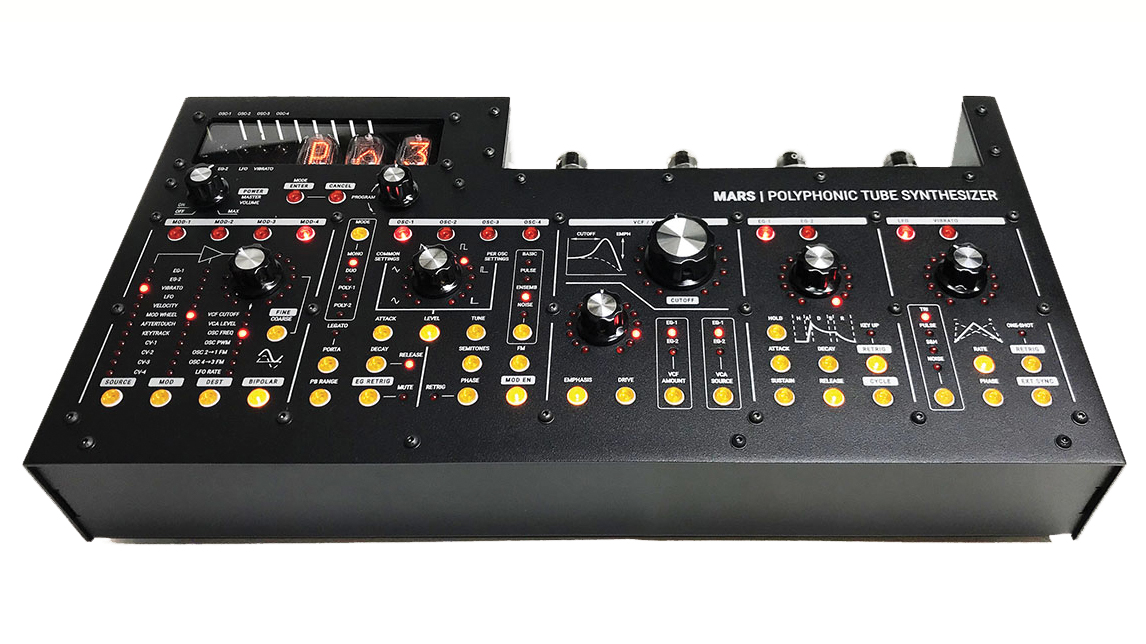Is Eternal Engine's Mars the world's first polyphonic vacuum tube synth?
Vintage meets contemporary in this DAW-controllable hybrid synth that blends digital oscillators with a tube-based audio path

The history of vacuum tubes in synthesizers goes all the way back to 1939: the Hammond Novachord, one of the first polyphonic synths ever commercially manufactured, relied on an array of 163 vacuum tubes to produce sound.
Tubes are expensive, power-hungry and unreliable in comparison to solid-state electronics, so their use in synthesizers never quite caught on, despite the warmth, character and organic texture that's characteristic of tube-based gear. In the modern era, only a handful of synths have incorporated vacuum tubes into their (monophonic) design: namely the Knif Audio Knifonium, the Erica Synths Fusion System II and Korg Volca Nubass.
Adding to that list is Eternal Engine's Mars, an instrument that its creator claims is the world's first polyphonic synthesizer "based on" vacuum tubes, a title that was arguably already snagged by the aforementioned Novachord. No matter: Mars looks like an intriguing instrument nonetheless, bringing together vintage tech with contemporary features in a design that's truly unique, whether or not it's the first.
Unlike some tube-based synths, Mars doesn't rely on vacuum tubes to generate sound. Instead, it's a hybrid instrument that features digital oscillators based on the R-2R TDA 1387, a vintage digital-to-analogue converter that Eternal Engine has employed as an oscillator, operating in four modes: Basic, offering sine, triangle, saw and fixed-width pulse waveforms, is joined by Pulse, Ensemble and Noise modes. (Mars is a four-voice synth with mono, duo and polyphonic modes.)
The oscillators run through a second-order voltage-controlled tube filter with self-oscillation and overload, so you'll be able to drive the filter to get some of that all-important harmonic saturation beloved of tube-based gear. Following that in the signal path is a VCA based on the architecture of tube opto compressors like the Teletronix LA-2A, along with a triode asymmetric overdrive for additional colour.
Sounds can be shaped via dual HADSR envelope generators with pre-delay and multiple retriggers, and additional modulation is provided by an LFO with morphable sawtooth-triangle-sawtooth and pulse-square-pulse waveforms, sample & hold and noise, routable via a four-channel mod matrix.
On the connectivity front, Mars is well-equipped, with MIDI in/out, four channels of CV and a single gate output for interfacing with external gear, along with a USB output for hooking up with its dedicated plugin and controlling the synth via your DAW. On the audio side we have a master output, headphone output and aux input for running external signals through Mars' tubes.
Get the MusicRadar Newsletter
Want all the hottest music and gear news, reviews, deals, features and more, direct to your inbox? Sign up here.
Mars' rather impressive retro design goes all in on the tube factor, with its four vacuum tubes exposed in a recessed panel at the top of the interface and joined by a display that uses three Nixie tubes to show parameter values.
Eternal Engine Mars is priced at $2199. Find out more on Eternal Engine's website.

I'm MusicRadar's Tech Editor, working across everything from product news and gear-focused features to artist interviews and tech tutorials. I love electronic music and I'm perpetually fascinated by the tools we use to make it. When I'm not behind my laptop keyboard, you'll probably find me behind a MIDI keyboard, carefully crafting the beginnings of another project that I'll ultimately abandon to the creative graveyard that is my overstuffed hard drive.
You must confirm your public display name before commenting
Please logout and then login again, you will then be prompted to enter your display name.
“Do you dare to ditch those ‘normal’ beats in favour of hands-on tweaking and extreme sounds? Of course, you do”: Sonicware CyDrums review
“Excels at unique modulated timbres, atonal drones and microtonal sequences that reinvent themselves each time you dare to touch the synth”: Soma Laboratories Lyra-4 review










